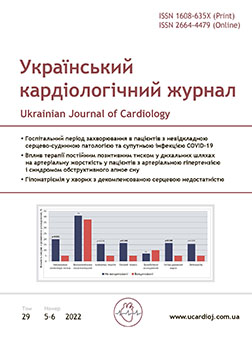Thrombosis in the cavity of the left ventricle. Part 1. Causes, diagnosis, prevention of formation
Main Article Content
Abstract
More than 100 years have passed since the first description of intracavitary thrombi, but the problem of diagnosis of thrombi, risk factors for development, as well as the impact of myocardial revascularization remain is a very relevant problem today, which definitely affects the prevalence of thrombi formation in the cavity of the left ventricle (LV). This review is devoted to the description and analysis of the main methods of diagnosing the presence of a thrombus in the cavity of the LV and factors affecting the formation of a thrombus. The most adequate method for diagnosing left ventricular thrombosis is a cardiac magnetic resonance imaging, but a simpler method such as transthoracic echocardiography can be used as a screening method for most patients. Determining the causes of LV thrombosis, such as reduced ventricular mobility, local myocardial damage, the presence of hyper coagulation and inflammatory phenomena, contributes to the adequate treatment of patients and the necessary prevention of thrombus formation.
Article Details
Keywords:
References
Barkhausen J, Hunold P, Eggebrecht H, et al. Detection and characterization of intracardiac thrombi on MR imaging. AJR Am J Roentgenol. 2002;179(6):1539-1544. doi:https://doi.org/10.2214/ajr.179.6.1791539
Bean WB. Infarction of the heart. III. Clinical course and morphological findings. Ann Intern Med 1938;12:71-94. doi:https://doi.org/10.7326/0003-4819-12-1-71
Bulluck H, Chan MHH, Paradies V, et al. Incidence and predictors of left ventricular thrombus by cardiovascular magnetic resonance in acute ST-segment elevation myocardial infarction treated by primary percutaneous coronary intervention: a meta-analysis. J Cardiovasc Magn Reson. 2018;20(1):72. Published 2018 Nov 8. doi:https://doi.org/10.1186/s12968-018-0494-3
Camaj A, Fuster V, Giustino G, et al. Left Ventricular Thrombus Following Acute Myocardial Infarction: JACC State-of-the-Art Review. J Am Coll Cardiol. 2022;79(10):1010-1022. doi:https://doi.org/10.1016/j.jacc.2022.01.011
Cambronero-Cortinas E, Bonanad C, Monmeneu JV, et al. Incidence, Outcomes, and Predictors of Ventricular Thrombus after Reperfused ST-Segment-Elevation Myocardial Infarction by Using Sequential Cardiac MR Imaging. Radiology. 2017;284(2):372-380. doi:https://doi.org/10.1148/radiol.2017161898
Cheitlin MD, Alpert JS, Armstrong WF, et al. ACC/AHA Guidelines for the Clinical Application of Echocardiography. A report of the American College of Cardiology/American Heart Association Task Force on Practice Guidelines (Committee on Clinical Application of Echocardiography). Developed in collaboration with the American Society of Echocardiography. Circulation. 1997;95(6):1686-1744. doi:https://doi.org/10.1161/01.cir.95.6.1686
Cheitlin MD, Armstrong WF, Aurigemma GP, et al. ACC/AHA/ASE 2003 guideline update for the clinical application of echocardiography: summary article: a report of the American College of Cardiology/American Heart Association Task Force on Practice Guidelines (ACC/AHA/ASE Committee to Update the 1997 Guidelines for the Clinical Application of Echocardiography). Circulation. 2003;108(9):1146-1162. doi:https://doi.org/10.1161/01.CIR.0000073597.57414.A9
Garvin C.F. Mural thrombi in the heart. The American Heart Journal. 1941: 21(6):713–720. doi:https://doi.org/10.1016/S0002-8703(41)90800-1
Habash F, Vallurupalli S. Challenges in management of left ventricular thrombus. Ther Adv Cardiovasc Dis. 2017;11(8):203-213. doi:https://doi.org/10.1177/1753944717711139
Hunter J: An account of the dissection of morbid bodys. A manuscript in the Library of the Royal College of Surgeons, London, 1757. 32:30.
JORDAN RA, MILLER RD, EDWARDS JE, PARKER RL. Thrombo-embolism in acute and in healed myocardial infarction. I. Intracardiac mural thrombosis. Circulation. 1952;6(1):1-6. doi:https://doi.org/10.1161/01.cir.6.1.1
Kurt M, Shaikh KA, Peterson L, et al. Impact of contrast echocardiography on evaluation of ventricular function and clinical management in a large prospective cohort. J Am Coll Cardiol. 2009;53(9):802-810. doi:https://doi.org/10.1016/j.jacc.2009.01.005
Kusnetzky LL, Khalid A, Khumri TM, Moe TG, Jones PG, Main ML. Acute mortality in hospitalized patients undergoing echocardiography with and without an ultrasound contrast agent: results in 18,671 consecutive studies. J Am Coll Cardiol. 2008;51(17):1704-1706. doi:https://doi.org/10.1016/j.jacc.2008.03.006
Di Odoardo LAF, Stefanini GG, Vicenzi M. Uncertainties about left ventricular thrombus after STEMI. Nat Rev Cardiol. 2021;18(6):381-382. doi:https://doi.org/10.1038/s41569-021-00539-y
Main ML, Goldman JH, Grayburn PA. Thinking outside the “box”-the ultrasound contrast controversy. J Am Coll Cardiol. 2007;50(25):2434-2437. doi:https://doi.org/10.1016/j.jacc.2007.11.006
Main ML, Ryan AC, Davis TE, Albano MP, Kusnetzky LL, Hibberd M. Acute mortality in hospitalized patients undergoing echocardiography with and without an ultrasound contrast agent (multicenter registry results in 4,300,966 consecutive patients). Am J Cardiol. 2008;102(12):1742-1746. doi:https://doi.org/10.1016/j.amjcard.2008.08.019
Mansencal N, Nasr IA, Pillière R, et al. Usefulness of contrast echocardiography for assessment of left ventricular thrombus after acute myocardial infarction. Am J Cardiol. 2007;99(12):1667-1670. doi:https://doi.org/10.1016/j.amjcard.2007.01.046
Massussi M, Scotti A, Lip GYH, Proietti R. Left ventricular thrombosis: new perspectives on an old problem. Eur Heart J Cardiovasc Pharmacother. 2021;7(2):158-167. doi:https://doi.org/10.1093/ehjcvp/pvaa066
McCarthy CP, Vaduganathan M, McCarthy KJ, Januzzi JL Jr, Bhatt DL, McEvoy JW. Left Ventricular Thrombus After Acute Myocardial Infarction: Screening, Prevention, and Treatment. JAMA Cardiol. 2018;3(7):642-649. doi:https://doi.org/10.1001/jamacardio.2018.1086
Nay R.M., Barnes A.R., Minn R. Incidence of embolic or thrombotic processes during the immediate convalescence from acute myocardial infarction. American Heart Journal 1945; 30(1):65-76.
Pöss J, Desch S, Eitel C, de Waha S, Thiele H, Eitel I. Left ventricular thrombus formation after ST-segment-elevation myocardial infarction: insights from a cardiac magnetic resonance multicenter study.Circ Cardiovasc Imaging. 2015; 8:e003417. doi: https://doi.org/10.1161/CIRCIMAGING.115.003417
Velangi PS, Choo C, Chen KA, et al. Long-Term Embolic Outcomes After Detection of Left Ventricular Thrombus by Late Gadolinium Enhancement Cardiovascular Magnetic Resonance Imaging: A Matched Cohort Study. Circ Cardiovasc Imaging. 2019;12(11):e009723. doi:https://doi.org/10.1161/CIRCIMAGING.119.009723
Velangi PS, Choo C, Chen KA, et al. Long-Term Embolic Outcomes After Detection of Left Ventricular Thrombus by Late Gadolinium Enhancement Cardiovascular Magnetic Resonance Imaging: A Matched Cohort Study. Circ Cardiovasc Imaging. 2019;12(11):e009723. doi:https://doi.org/10.1161/CIRCIMAGING.119.009723
Thanigaraj S, Schechtman KB, Pérez JE. Improved echocardiographic delineation of left ventricular thrombus with the use of intravenous second-generation contrast image enhancement. J Am Soc Echocardiogr. 1999;12(12):1022-1026. doi:https://doi.org/10.1016/s0894-7317(99)70097-0
Weinsaft JW, Kim HW, Shah DJ, et al. Detection of left ventricular thrombus by delayed-enhancement cardiovascular magnetic resonance prevalence and markers in patients with systolic dysfunction. J Am Coll Cardiol. 2008;52(2):148-157. doi:https://doi.org/10.1016/j.jacc.2008.03.041
Weinsaft JW, Kim RJ, Ross M, et al. Contrast-enhanced anatomic imaging as compared to contrast-enhanced tissue characterization for detection of left ventricular thrombus. JACC Cardiovasc Imaging. 2009;2(8):969-979. doi:https://doi.org/10.1016/j.jcmg.2009.03.017

